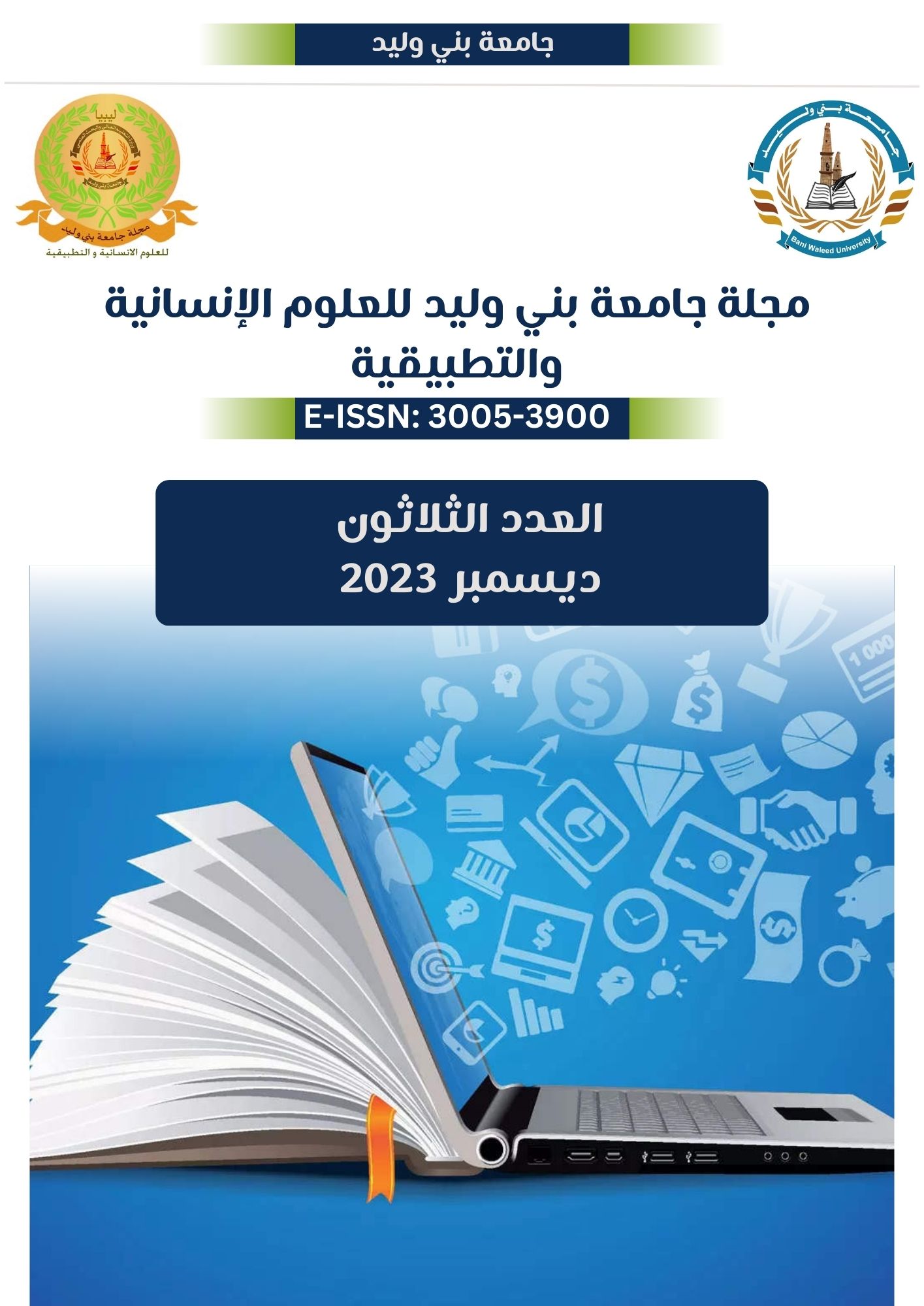The impact of the quality water intake on renal functions in kidney disease patients: A study in Western Libya
DOI:
https://doi.org/10.58916/jhas.v8i5.125Keywords:
Kidney disease, drinking water quality, kidney function, drinking water and its effect on kidney disease, kidney failure.Abstract
Introduction: owing to its rising incidence and prevalence throughout the world, and in specific places in Libya, kidney failure diseases has gained increasing significance among the researcher. In spite of this disease can occurs as a result of the combined influence of epidemiological, biochemical, metabolic, and genetic risk factors, one of the important factors that considered in this study is quality water consumption. Creatinine concentrations and blood urea nitrogen (BUN) can indicate renal function. Aim of study: The aims of present work were to assess the water drinking type that regularly consumed by kidney patients by measuring of creatinine and urea concentrations in plasma and urine samples.
Methodology: The study involved 97 patients from Zawiya Nephrology Centre and Al-Zahra Hospital in Libya, divided into four age groups. They answered a questionnaire about their personal information, drinking water quality, and urea and creatinine levels after dialysis. Blood samples were collected, then spun in a centrifuge. Data was analysed using Microsoft Excel and collected from personal information. Result. The study found that in Zawiya, 25.77% of the sample was female, while in Zahra, 18.18% was female. In Zawiya, 23.70% of the sample was male, while in Zahra, 28.86% was male. The study revealed that the age group aged 35-55 had the highest percentage (46.39%), followed by those aged 55+ (40.20%), and those aged 15-35 (13.40%), with no age group less than 15 years. The study assessed kidney function by estimating urea and creatinine content in blood. Results showed significant increases in renal function markers after dialysis, while no significant difference was observed in creatinine levels. The study found that most patients require dialysis three times a week for kidney failure, depending on the severity and stage of the disease. Conclusion: Kidney patients in Western Libya require clean, safe drinking water to prevent kidney patient deterioration. Research is needed to assess water quality's impact on kidney health, and a larger random offer trial is recommended.
Downloads
References
Kidney patients in Western Libya require clean, safe drinking water, and based on the findings of this study that showed significantly increased of kidney function markers, in particular urea. The results may be concluded that drinking water quality is essential for kidney patients in order to prevent kidney problems and health complications. Furthermore, to confirm findings of this study further investigations are required in several area and increase size of simples which considered as one of the important limitations in this study.
References
Al-Hisnawi RA, Salih H. A study of some biochemical changes in patients with chronic renal failure undergoing hemodialysis Int. J. Curr. Microbiol. App. Sci. 2014; 3(5): 581-586.
Aperia AC, Liebow Al. 1964. Implications of urine pO2 for renal medullary blood flow. American Journal of Physiology ,206(3): 499-504.
Aperia AC, Liebow Al. 1964. Implications of urine pO2 for renal medullary blood flow. American Journal of Physiology ,206(3): 499-504
Arain, M. B., Kazi, T. G., Baig, J. A., Afridi, H. I., Sarajuddin, Brehman, K. D., ... & Arain, S. S. (2015). Co-exposure of arsenic and cadmium through drinking water and tobacco smoking: risk assessment on kidney dysfunction. Environmental Science and Pollution Research, 22, 350-357.
Azra K. Estimation of blood urea (BUN) and serum creatinine level in patients of renal disorder. J Fundam Appl Sci. 2014; 4:199-202.
Bidwell GL III, Perkins E, Raucher D. A thermally targeted c-Myc inhibitory polypeptide inhibits breast tumor growth. Cancer Lett 319: 136–143, 2012. doi: 10.1016/j.canlet.2011.12.042. [PMC free article] [PubMed] [CrossRef] [Google Scholar] [Ref list]
Bonjour JP, Caverzasio JHC. 1984. Phosphate transport in the kidney. Reviews of Physiology, Biochemistry and Pharmacology, 100: 161- 21.
Carpenter, D.O.; Bushkin-Bedient, S. Exposure to Chemicals and Radiation during Childhood and Risk for Cancer Later in Life. J. Adolesc. Health 2013, 52, S21–S29. [CrossRef] [PubMed]
Cho S, Dong S, Parent KN, Chen M. Immune-tolerant elastin-like polypeptides (iTEPs) and their application as CTL vaccine carriers. J Drug Target 24: 328–339, 2016. doi: 10.3109/1061186X.2015.1077847. [PMC free article] [PubMed] [CrossRef] [Google Scholar] [Ref list]
Clark, W. F., Huang, S. H., Garg, A. X., Gallo, K., House, A. A., Moist, L., ... & Sontrop, J. M. (2017). The chronic kidney disease water intake trial: Protocol of a randomized controlled trial. Canadian Journal of Kidney Health and Disease, 4, 2054358117725106
Coresh, J.; Selvin, E.; Stevens, L.A.; Manzi, J.; Kusek, J.W.; Eggers, P.; Van Lente, F.; Levey, A.S. Prevalence of Chronic Kidney Disease in the United States. JAMA 2007, 298, 2038–2047. [CrossRef]
Dai L, Lu C, Liu J, Li S, Jin H, Chen F, Xue Z, Miao C. Impact of twice- or three-times-weekly maintenance hemodialysis on patient outcomes: A multicenter randomized trial. Medicine (Baltimore). 2020 May;99(20):e20202. doi: 10.1097/MD.0000000000020202. PMID: 32443343; PMCID: PMC7253701.
Eduardo OC, Kaue A, Idania AA, et al. Influence of hemodialysis on the plasma concentration of adenosine deaminase in patients with chronic kidney disease. J Bras Patol Med Lab. 2015; 51:153-157.
Evan AP, Vincet GH, Schwartz GJ. 1983. Development of solute transport in rabbit proximal tubule. II. Morphologic segmentation, American Journal of Physiology, 1245: F391-F407.
Evan AP, Vincet GH, Schwartz GJ. 1983. Development of solute transport in rabbit proximal tubule. II. Morphologic segmentation, American Journal of Physiology, 1245: F391-F407.
Francois H, Danielle C.1985. Functional segmentation of the nephron. In: The Kidney: Physiology and Pathophysiology, Seldin DW and Gicbisch G (editors). Raven Press, New York, pp. 519-529.
Geng Q, Sun X, Gong T, Zhang Z-R. Peptide-drug conjugate linked via a disulfide bond for kidney targeted drug delivery. Bioconjug Chem 23: 1200–1210, 2012. doi: 10.1021/bc300020f. [PubMed] [CrossRef] [Google Scholar] [Ref list]
George EM, Liu H, Robinson GG, Mahdi F, Perkins E, Bidwell GL III. Growth factor purification and delivery systems (PADS) for therapeutic angiogenesis. Vasc Cell 7: 1, 2015. doi: 10.1186/s13221-014-0026-3. [PMC free article] [PubMed] [CrossRef] [Google Scholar] [Ref list]
Grant, M.K.; Goldizen, B.F.C.; Sly, P.; Brune, M.M.-N.; Neira, M.; Berg, M.V.D.; Norman, R.E. Health consequences of exposure to e-waste: A systematic review. Lancet Glob. Health 2013, 1, e350–e361. [CrossRef]
Hall, M. E., do Carmo, J. M., da Silva, A. A., Juncos, L. A., Wang, Z., & Hall, J. E. (2014). Obesity, hypertension, and chronic kidney disease. International journal of nephrology and renovascular disease, 75-88
Hokamp, Jessica A., and Mary B. Nabity. "Renal biomarkers in domestic species." Veterinary clinical pathology 45.1 (2016): 28-56.
Holden, J. A., Layfield, L. L., & Matthews, J. L. (2013). The zebrafish: atlas of macroscopic and microscopic anatomy. Cambridge University Press
Hwang, S.-J.; Tsai, J.-C.; Chen, H.-C. Epidemiology, impact and preventive care of chronic kidney disease in Taiwan. Nephrology 2010, 15 (Suppl. S2), 3–9. [CrossRef]
Imai, E.; Horio, M.; Iseki, K.; Yamagata, K.; Watanabe, T.; Hara, S.; Ura, N.; Kiyohara, Y.; Hirakata, H.; Moriyama, T.; et al. Prevalence of chronic kidney disease (CKD) in the Japanese general population predicted by the MDRD equation modified by a Japanese coefficient. Clin. Exp. Nephrol. 2007, 11, 156–163. [CrosRef]
Inker, L.A.; Levey, A.S.; Pandya, K.; Stoycheff, N.; Okparavero, A.; Greene, T. Chronic Kidney Disease Epidemiology Collaboration (CKD-EPI) Early Change in Proteinuria as a Surrogate End Point for Kidney Disease Progression: An Individual Patient Metaanalysis. Am. J. Kidney Dis. 2014, 64, 74–85. [CrossRef] [PubMed]
Jha, V.; Garcia-Garcia, G.; Iseki, K.; Li, Z.; Naicker, S.; Plattner, B.; Saran, R.;Wang, A.Y.-M.; Yang, C.-W. Chronic kidney disease: Global dimension and perspectives. Lancet 2013, 382, 260–272. [CrossRef]
Landrigan, P.J.; Sly, J.L.; Ruchirawat, M.; Silva, E.R.; Huo, X.; Diaz-Barriga, F.; Zar, H.J.; King, M.; Ha, E.H.; Asante, K.A.; et al. Health Consequences of Environmental Exposures: Changing Global Patterns of Exposure and Disease. Ann. Glob. Health 2016, 82, 10–19. [CrossRef] [PubMed]
Levey, A.S.; De Jong, P.E.; Coresh, J.; Nahas, M.E.; Astor, B.C.; Matsushita, K.; Gansevoort, R.T.; Kasiske, B.L.; Eckardt, K.-U. The definition, classification, and prognosis of chronic kidney disease: A KDIGO Controversies Conference report. Kidney Int. 2011, 80, 17–28. [CrossRef] [PubMed]
Lin Y, Li Y, Wang X, Gong T, Zhang L, Sun X. Targeted drug delivery to renal proximal tubule epithelial cells mediated by 2-glucosamine. J Control Release 167: 148–156, 2013. doi: 10.1016/j.jconrel.2013.02.001. [PubMed] [CrossRef] [Google Scholar] [Ref list]
Lise B, Nadine B, Marie till'. 1987. 11ccerogcrcify of nephron anatomy. Kidney International, 31: S25-S39.















